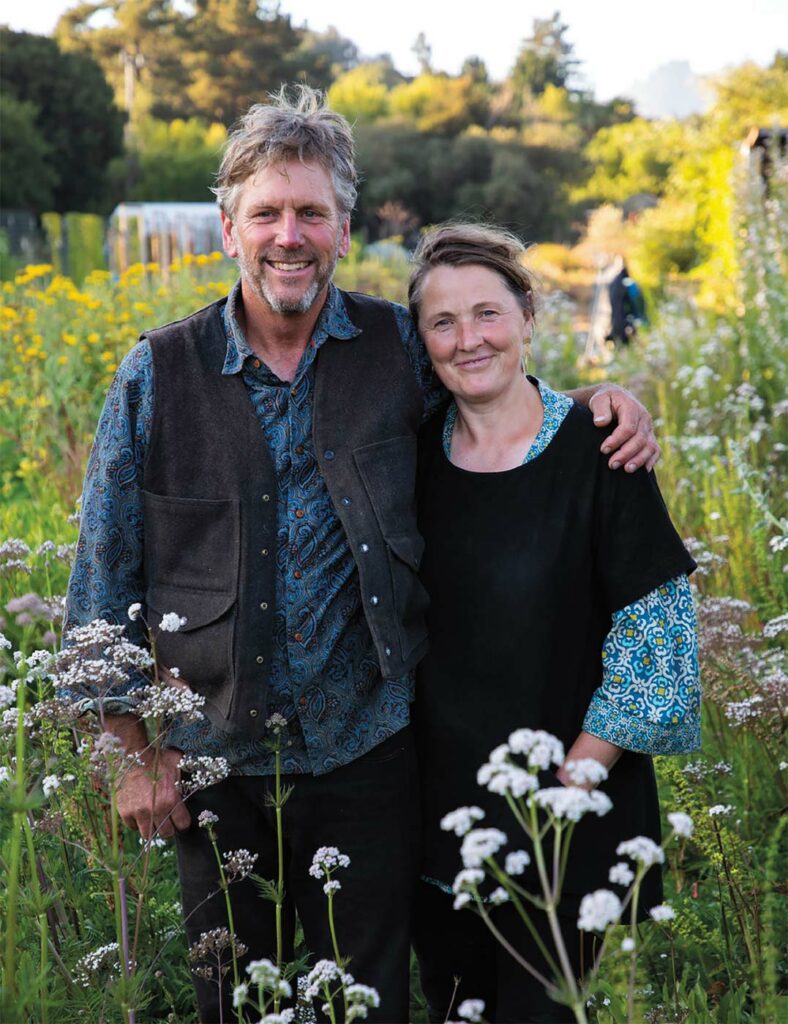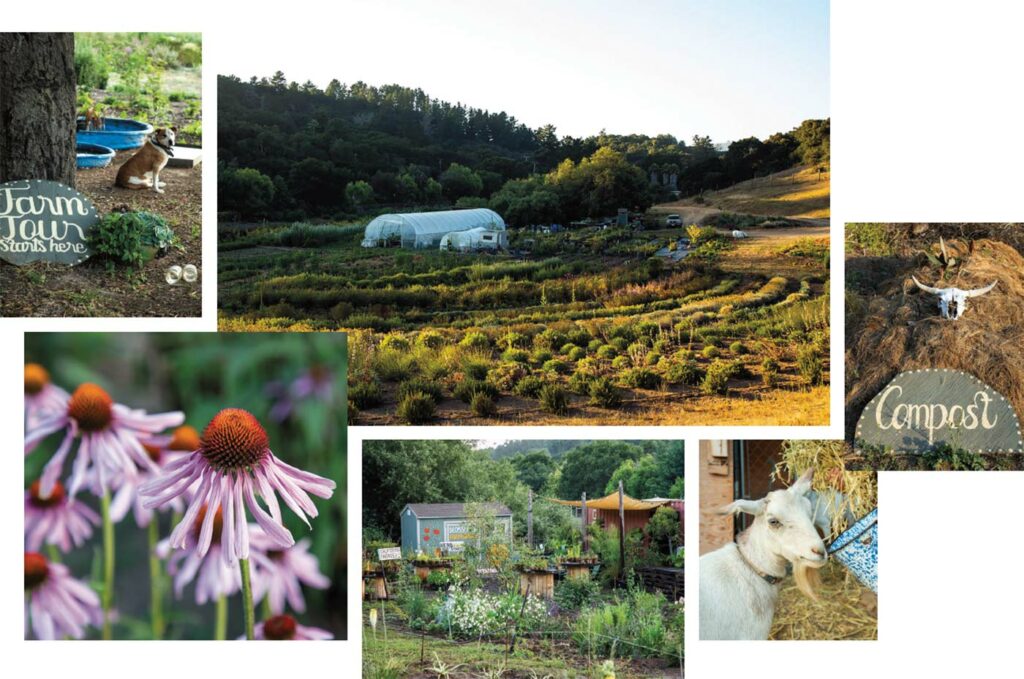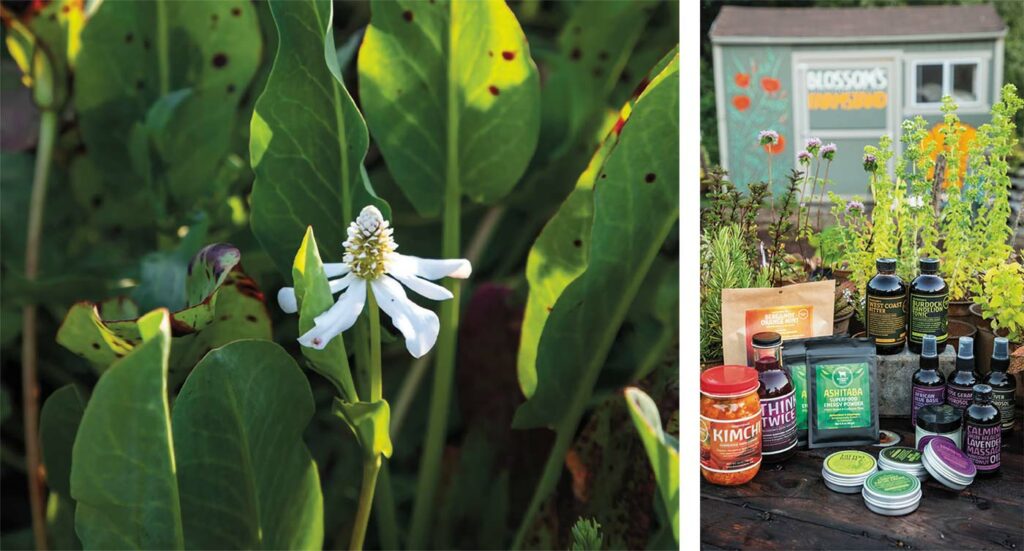
Blossom’s Farm comes to Aromas
PHOTOGRAPHY BY MICHELLE MAGDALENA
Our planet needs healing, and Delmar McComb and Carin Fortin of Blossom’s Biodynamic Farm in Aromas are committed to being part of the cure.
They provide a model deliberately designed to spark your curiosity. And while they are happy to sell you some home-brewed kombucha or herbal skin cream, they are even happier to teach you the biodynamic principles and practices they follow, healing the earth—and people too—as they farm.
The couple grows a huge variety of medicinal plants and turns them into an array of tinctures, salves and hydrosols. They also teach classes and workshops on the art of biodynamic living on their 45-acre property and sell their products at farmers markets throughout the Monterey Bay area.
After more than 10 years of farming on leased land, first in Bonny Doon and then in Corralitos, McComb and Fortin decided they needed to put down permanent roots. With lots of help, they found a gently sloping southwest-facing farm at the western edge of Aromas on San Juan Road.
When they moved in during the spring of 2022, the region was experiencing a third year of severe drought, and irrigation lines had to be put in place to get trees and other plants started.
“The land was essentially fallow when we purchased it,” says McComb. “The former owner had a greenhouse, which he removed before we arrived. He was not organic, but one does not need to be certified organic to sell herbal products.”
While striving to “perennialize” the farm as much as possible with plants and herbs that come back year after year and do not require tillage, McComb says he is not inherently anti-tillage.
“In areas where we have annual plants, we do till as needed but always with adding compost in during the process,” he says. “We know that tilling can be destructive to the soil and soil life, but when used properly, tilling is a tool that can allow cosmic forces to actually enter the soil and to allow an explosion of microbial life as well. It’s all about timing.”
While many people are learning that “no-till” farming helps preserve the lives of soil microbes and keeps greenhouse gasses sequestered underground, there is a time when tillage is important, and that’s right at the beginning when the farm’s layout is being established.
This approach allows a regenerative “farm organism” to develop over time that is in harmony with both the environment and the cosmos as a whole.

The ultimate goal is to set up a farm perimeter like a “skin” with hedgerows and shrubs that attract pollinators, birds and other beneficial insects, and then simply let it grow.
McComb and Fortin chose a curved terrace system for their perennial herbs and flowers. By using their own farm-made compost “teas” derived from various ingredients including nettle, comfrey and whey, and using other biodynamic preparations, they practice reciprocity in the rich biodiversity of their homestead. Their house is nestled back on a hillside covered with shade-providing coastal live oaks.
Transformation of this land is currently up and running with several interns, apprentices, one employee and a few key volunteers lending a hand.
The rhythm of each day begins at dawn with milking one cow and tending the other animals. Most days the truck must be packed for regional farmers markets and then there’s breakfast together and a half hour check-in to find out how everyone is feeling.
“The rhythms of the land anchor us,” Fortin says.
Residing on this property just one year, McComb embraces the challenges of establishing a biodynamic farm capable of certification. Comprehensive in scope, taking into account everything from the cycles of the moon and stars to the soil, plants, animals and people, biodynamic farming involves attention to detail.
This approach allows a regenerative “farm organism” to develop over time that is in harmony with both the environment and the cosmos as a whole. The resulting harvests of this farm organism provide foods and medicines that are truly nutritious and full of vital energies, as the farm’s website describes.
“I’ve tried to re-word the biodynamic messaging to make it more accessible to the growing number of people embracing regenerative agriculture,” McComb tells me, figuring if the spiritual connection goes unspoken, it will still be there.
Biodynamic farming grew out of the life-long dedication of German scientist and philosopher Rudolf Steiner to help humanity develop its full potential. He saw human separation from nature as a rift that needed to be healed.
Steiner joined with other land stewards in the early years of the 20th century to fortify and defend farming practices that for centuries had no need of chemical fertilizers or pesticides. Because this was happening at the end of his life, others took up the cause and devised the Biodynamic Demeter Society, still going strong today and offering certification.
In biodynamics, it’s understood that there is a collaborative, co-creative association with nature. It’s not that one dominates and extracts from nature what one wants or needs. But it is also not a “humans are bad, don’t do anything that isn’t natural” approach either.

“It’s an approach where the farmer listens to and observes what the land, animals and plants need while also being a ‘conductor’ of the farm ‘orchestra,’ working in concert with, in tune with and in harmony with nature all at a tempo that is sustainable,” says McComb. “I can’t really say it better than farm legend Alan Chadwick”: There is one rule in the garden that is above all others. You must give to nature more than you take. Obey it, and the earth will provide you in glorious abundance. — Alan Chadwick
You’ve likely heard the term “regenerative agriculture” tossed around; it’s definitely trending right now as a way to feed the world healthy food while sequestering carbon. What happens on 30% of the earth’s land surface—the amount we cultivate for food, fiber and medicine—could make a a measurable difference in slowing global warming.
So take a step back and observe the earth. The hydrological cycles determine the weather. The earth functions best for humans when there are enough green canopies and roots in the ground to absorb and release water. As forests and perennial farmlands breathe in carbon dioxide, sequestering carbon in the process, humans inhale the life-giving oxygen plants exhale. If we can manage this well, we just might go back to a time when we get enough rain in predictable amounts to nourish our crops.
Whom should we be supporting in this endeavor? We’ll get the best result when we switch our buying habits from industrial to regenerative agriculture.
Blossom’s Farm welcomes all farmers, gardeners and community members to delve into new methods of growing food, fiber and medicine in a way that heals the earth and addresses climate change directly.
Blossom’s Farm
2033 San Juan Road, Aromas
blossomsfarm.com
About the author
Ellen Farmer is a freelance writer and organizer living in Santa Cruz.
- Ellen Farmerhttps://www.ediblemontereybay.com/author/efarmer/
- Ellen Farmerhttps://www.ediblemontereybay.com/author/efarmer/
- Ellen Farmerhttps://www.ediblemontereybay.com/author/efarmer/
- Ellen Farmerhttps://www.ediblemontereybay.com/author/efarmer/


